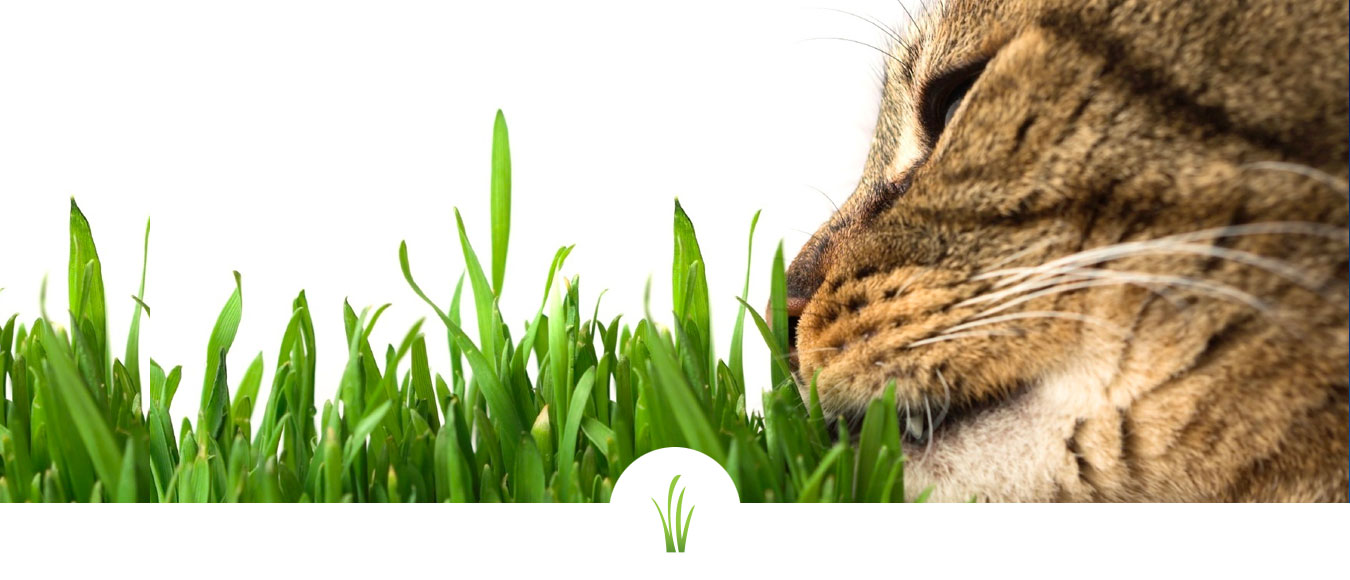The Importance of Greens for Feline Health

Cats are carnivores - every bit of their anatomy and physiology screams out, “I am a meat-eater!” But it turns out that, in nature, cats don’t only eat meat. Virtually every cat species studied normally eats some green plants and grasses — and, of course, they get the benefit of the vegetable matter their prey has eaten.
So why do cats eat grass? And why should we provide Cat Grass, or the benefits of Cat Grass (most commonly wheatgrass), to our feline companions? There is plenty of wholesome green nutrition available from plants, including:
- Fiber: The most obvious nutrient that cats get from Cat Grass is fiber. Fiber is an indigestible carbohydrate made only by plants. It helps regulate digestive functions, moderates the passage of food through the digestive system, and nourishes the normal bacteria and cells in the colon, promoting healthy elimination of wastes. Cats don’t need very much fiber, but they clearly prefer to have some. Wheatgrass is an excellent source of insoluble fiber.
- Silica: Along with fiber, upright plants like wheatgrass also contain a fair amount of silica, which is a mild irritant. Cats sometimes seem to consume plants in order to trigger vomiting—which can help clear out fur they have ingested while grooming, and other unwanted debris they may have consumed (whether accidentally or deliberately!)
- Vitamins: Wheatgrass is full of B vitamins (including riboflavin, niacin, pantothenic acid, biotin, thiamine, and pyridoxine) and related B-vitamin compounds (such as choline and inositol), ascorbic acid (vitamin C), vitamin E (both alpha and gamma tocopherols) and vitamin K1 (phylloquinone).
- Minerals: There are many vital trace minerals in wheatgrass, including boron, copper, manganese, selenium, and sulfur. No minimum requirement of sulfur exists, but we know that it is essential for connective tissue formation and other important functions. Since body sulfur reserves decrease with age, supplementation is even more important for older cats.
- Amino acids: The building blocks of proteins are the 22 “standard” amino acids. Wheatgrass contains 17 of them, including 7 of the 11 that are essential for cats (in cats, taurine is also essential.)
- Enzymes: Wheatgrass contains the digestive enzymes that will help your cat get the maximum nutritional value from food and it also includes many other bioactive enzymes.
- Antioxidants: Everyone has heard of antioxidants, and many of us take them ourselves, but few understand what they do and why they are so important. To do that, we need to understand a little bit about cellular metabolism. (Don’t worry, there won’t be a quiz!)
All cells, from those found in bacteria to blue whales, need energy to maintain and repair themselves, as well as to perform their particular functions. That molecule of energy is ATP (adenosine tri-phosphate.) The engine that burns fuel to produce ATP is the mitochondrion, a tiny organ (organelle) within the cell; very busy cells may have thousands of mitochondria.
The preferred fuel of this mitochondrial engine is oxygen, and the last step in ATP formation is oxidation. Like combustion in a car engine, when fuel is burned, energy is produced, but by-products are also created. And just as with gasoline, some of the by-products of the mitochondrial combustion engine are toxic. In cells, some of the by-products are highly unstable molecules called "oxygen free radicals." Internal processes like inflammation, and external influences such as radiation, pesticides and cigarette smoke can cause increased free radicals.
Free radicals are not all bad. For one, they are essential for the immune system. White blood cells attack and kill invading organisms by pumping free radicals into them. However, excessive free radical formation is harmful. They can damage enzymes, fats, DNA, and other molecules. Accumulated free radical damage over time is a major factor in many of the ailments associated with aging, such as arthritis, diabetes, and thyroid disease.
While cats can and do produce their own natural antioxidants, it is clear from the increase in degenerative diseases that they don’t produce enough to combat the extraordinary stresses of modern life. Supplementing with natural antioxidants from whole foods is the smart thing to do.
Vitamins C and E are the best-known antioxidants, but there are many others. Wheatgrass contains not only ascorbic acid and tocopherols (vitamins C and E), but also other flavonoids and tocopherols, carotenes, glutathione, chlorophyll, lecithin, lutein, and several antioxidant amino acids.

Cancer- and Tumor-Fighting Compounds
Many cancers are thought to have their origins in oxidative damage to DNA—oxidation that can be moderated by antioxidants. Cancer is also thought to be a failure of the immune system’s surveillance for abnormal cells. Supporting the cat’s body with antioxidants supports the immune system and may have other inhibiting effects on the formation of tumors.
Wheatgrass contains many antioxidants as well as other compounds that are known to have anti-cancer or anti-tumor actions. These include alpha and gamma tocopherol, apigenin, ascorbic acid, beta-carotene, caffeic acid, lecithin, lutein, phytic acid, and quercitin. Even plant fiber is now recognized as having potential anti-cancer activity. Researchers are currently studying the use of wheatgrass as a potential adjunctive therapy in human cancer patients.
So, there you have it! Green nutrition is important for our feline friends, so do your cat a favor and grow some of that yummy Cat Grass at home, or use green treats every day!